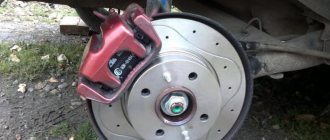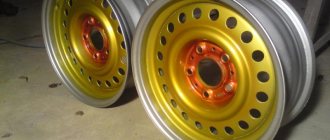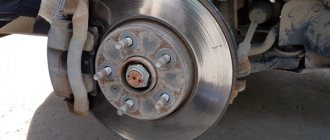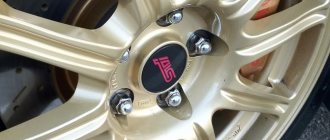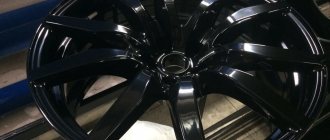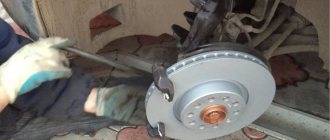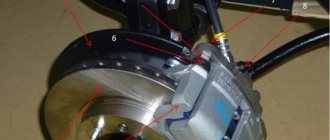Many car owners sooner or later think about turning brake discs, but most of them do not understand how it is done and whether it is justified at all. Let's figure it all out.
Constant trips by car force the driver to more closely monitor the condition of the “iron horse” and promptly respond to any malfunctions.
In particular, brake pads and discs, which are the “weakest link” of the braking system, require special care.
And if in the case of brake pads the best option is replacement, then the “life” of the brake discs can be extended by performing a number of measures.
All that is needed is timely grooving of the brake discs.
Why do they change or sharpen?
In fact, you can ride these too! BUT it’s not just that you come to the service center and complain that when you press the brake pedal you have:
- The steering wheel hits so hard you can't just hold it
- There is a very strong vibration in the body
- By the way, many people also experience extraneous sounds in the suspension
It is worth noting that they actually last about two to three times when changing the brake linings, and then they need to be changed.
The thing is that with high mileage, the pads fill grooves on the surface of the disc, the sides become non-parallel, and pits and protrusions form. An edge forms on the top of the disc.
Also, temperature changes when you abruptly drive into a puddle can really lead to it, that is, as our common drivers say, “carobit.”
And now, when you press the brake pedal, the pads are pressed against the disc under the influence of the caliper pistons, and all these irregularities are transmitted to the steering wheel or even the suspension and body.
Well, what remains is either to install completely new ones, or to sharpen these old ones, and not much, but to a small size (more on this a little later).
This is interesting: How to make the suspension softer?
Pros and cons of grooving
All shortcomings can be easily eliminated after turning the disc, but it is important to understand that this procedure cannot be carried out an infinite number of times. Sooner or later the disk will have to be replaced. At the moment when its thickness reaches the minimum specified for this type of car. This is the main disadvantage of the groove - the disc gradually becomes thinner, and this leads to its fragility.
The main advantage is the price. If you have to fork out 10-40 thousand rubles to replace a new disk, depending on the car model, then turning it will cost 4-5 times less.
About the price
As we have already talked to you, it costs VERY, VERY MUCH to install new ones! For example, for business class it generally costs from 25 to 40,000 for originals. How much will it cost to sharpen? I’ll answer right away - much cheaper, about 4 sometimes 5 times! And if you find a guy who does this for himself, as a “coven”, then you can generally do it for 1500 rubles per pair, this is what my friend did for a CAMRI
There are also two types of grooves:
- With removal, when the entire operation is carried out on the machine
- Without removal, when a special machine with two cutters is attached to the wheel hub and it sharpens the surfaces
If you contact a service station for a process with removal , then it turns out that the average prices are approximately the following:
- Car “A” and “B” class - approximately 3000 - 3500 rubles per pair
- “C” class – 3500 – 4000
- "D" about 5000 - 6000 rubles.
I don’t know about other classes; as a rule, executive cars are serviced with new spare parts.
If we take the process without removal , then the prices are slightly lower, by about 500 - 1000 rubles. It’s like what kind of service will bend you. Why is it cheaper, simply because there is no need to remove the disks and carry them somewhere, put them on machines and stuff the internal “mirror” or as they also call the plane. It’s trivial that all two planes are less of a hassle (I’ll explain a little later).
Pros and cons of grooving
We have already talked a lot about the advantages above, as it seems to me the main thing here is PRICE! Once again, the cost is 4–5 times cheaper than buying a new sample.
But there are also a lot of disadvantages here. Moreover, they do not relate to grooving methods, but rather to the greed of craftsmen or service stations.
Wheels for budget cars are made mainly from cast iron alloys. Of course, sports and expensive cars can have ceramic or even composite ones installed, but for the budget class this is rare.
There is such a thing as minimum thickness ; you should not violate it. These are different indicators for different types of cars. It is also worth distinguishing between ventilated and non-ventilated disk systems. For example, on our VAZ the minimum thickness (non-ventilated) is 10.8 mm, ventilated - 17.8 mm, if you take Renault or Nissan - 20 mm
WHAT HAPPENS IF YOU TURN MORE? This is where the main reason for disc failures (and the greed of the craftsmen) lies; if you remove more metal, then the blade itself becomes very fragile, it quickly heats up when braking, and if you get into a puddle due to temperature changes, there is a high chance that it will be much will drive faster. It can also simply split or break, which is already dangerous, because it turns out that at speed one wheel can suddenly lock. And here we are not far from a major accident. Masters who, although they want to make money from you, know this, but often turn a blind eye to it and sharpen it anyway, THIS IS WRONG. We must always remain human.
In general, if the thickness is critically minimal, for example, 150 - 200,000 kilometers have passed, then I strongly advise you not to sharpen them! As sad as it sounds, BUT HERE IS ONLY A REPLACEMENT.
Entry of dirt and foreign objects
Most often, a problem is signaled by extraneous noises that occur not only during braking, but also when the car is moving in various modes.
It can be either a quiet rustle or a grinding sound that hurts the ear.
When the first suspicions arise, it is worth inspecting the components of the brake system, clearing them of foreign objects and contaminants. In the case of disks, this usually requires blowing out the components with compressed air or removing the foreign object with a screwdriver.
It's more difficult with drums. They definitely have to be removed. If scratches and grooves are found on the metal surface, it means that discs or drums need to be resurfaced. The sooner you do this, the greater the chance of extending the life of the damaged part.
Souring or uneven operation of the cylinders
Souring of calipers and cylinders is a frequently occurring problem associated with damage to the protective boots or the fact that the car has not been used for a long time. In both cases, corrosive damage to the surface of the pistons occurs with the formation of a rather thick layer of oxides on them, which impedes the normal operation of the mechanism. The following steps must be taken:
- Restore the mobility of components by cleaning them from corrosion.
- Replace damaged boots and seals.
But if measures to eliminate the malfunction are taken late, the damage to the working surface of the disk or drum is great, and grooves cannot be avoided.
Grooving brake discs. Video:
Summarize
Sometimes there is no point in grooving. As noted above, today there are a huge number of Chinese brake discs. It is worth noting that not all of them are of poor quality. You can also pay attention to European analogues. Reasonable price tag and fairly good metal. Try not to brake at high speed in puddles, because overheating and sudden cooling often lead to bending of the brake disc.
Source fb.ru
AutoOt.ru » Car repair » Grinding brake discs with your own hands.
A popular procedure among many car enthusiasts, turning brake discs and drums is a good way to extend the life of critical parts.
Scratches and grooves formed on the working surface of the part affect the operation of the entire braking system. They arise for various reasons. Among the most likely:
- Dirt and foreign objects such as sand, small pebbles, glass shards or metal shavings get into the gap between the friction lining and the disc surface.
- Souring or uneven operation of the cylinders and calipers pressing on the pads.
- Distorted brake pads due to improper installation.
- Poor quality friction lining material.
- Overheating and disk deformation.
- Natural wear of metal due to friction.
- Late replacement of brake pads.
All this is not at all a reason to send expensive components for scrap. Many problems can be avoided if the necessary measures are taken in a timely manner. It is much wiser not to think about how to groove brake discs with your own hands, but to prevent the occurrence of a malfunction.
Withdrawal process
Here, on the one hand, everything is much easier, on the other, much more difficult. It’s easier because the disc can be completely removed, there is no need to hang the caliper and attach any parts to the suspension itself. What’s more difficult is that you need to grind not just one surface, but three at once! Moreover, it is worth doing without removing the disk, it is fixed once, and we go through all the surfaces at once. If you shoot, the parallelism of the planes will definitely be broken, so you will make things even worse.
REMEMBER!!! In the method of grooving with removal, you need to process three surfaces at once WITHOUT REMOVING FROM THE MACHINE - the top, bottom and near the hub, so that they are all perfectly parallel! Otherwise there will be beating.
The whole difficulty here is that the cutter on the outside is easy to find, but it is DIFFICULT to climb back without removing it. A certain “device” will be required, such as a reverse cutter or a special machine.
The disadvantage of this method is that many craftsmen make a groove by removing it and turning it on the other side, which actually makes it even worse.
When not to grind wheels
In the case of brake discs, there is a concept of minimum thickness. It is strictly not recommended to go beyond these values.
For a moment, you should imagine that the motorist has worn off more than is provided for by the disk configurations and recommendations for its operation.
In such a situation, the following changes are expected:
- the fragility of the metal increases;
- the disc heats up faster during braking;
- with a sharp temperature change the disk will move;
- there is a possibility of splitting, breaking, or cracking.
As a result, when braking at speed, the wheel may suddenly lock. It's not difficult to imagine the possible consequences.
You should not rely completely on the masters. Some of them know that the disc can no longer be turned; it has used up its resource. But in order to earn money, he agrees to take the job without notifying the car owner of the possible risks.
When there is a need for grooving
Each car comes with documentation from the manufacturer, in which you can find recommendations for operation and repair. It also describes the technical and operational characteristics of various systems, including the brake system.
Before and after grooving
The average for modern cars is a mileage of up to 100 thousand km for brake discs and up to 30 thousand for pads. Mileage recommendations vary depending on the make, model, or year of the vehicle.
Also, the intensity of wear is influenced by individual driving style. Frequent braking or sharp braking at high speed results in greater wear and tear on the disc/pad pair.
Early wear of this unit can be detected by several signs:
- intense heating of the disks , which can be noticed after a relatively short run by touching any part of it;
- extraneous sounds occur (creaking, whistling, etc.) after pressing the pedal;
- the braking distance has increased and the efficiency of the system has decreased;
- during braking, the steering wheel vibrates , sometimes it is supplemented by a slight kickback in the pedal;
- inspection of the disc revealed obvious wear and corrosion elements with possible mechanical damage.
Any one of these reasons will be enough to look for a machine for turning brake discs without removal or with removal. However, if this operation has already been carried out repeatedly with this car, then it is necessary to control the thickness of the discs so as not to oversharpen them. The minimum size is specified by car manufacturers in the car's operating instructions.
This is interesting: Do-it-yourself repair and replacement of the camshaft when worn
Service life of brake system parts, disc grinding methods
Like all components and mechanisms in a car, parts of the brake system (TS) are subject to wear; they have a certain service life set by the manufacturer. On average, pads last from 20 to 50 thousand km, brake discs (BD), as a rule, last twice as long. But the resource may be different, it depends:
- on driving style;
- weather conditions;
- quality of materials;
- compliance with standards during repairs.
With frequent braking and sudden pressing of the brake pedal, parts wear out more intensely, heating causes deformation of the brake pedal, and because of this, the brake pads also work unevenly. Also, the service life of pads and discs is reduced when the car is used in wet weather; non-original spare parts of dubious manufacture do not last long.
It is advisable to replace TDs if their working surface is worn beyond the established norm, or the spare parts themselves are inexpensive. Of course, you can always buy new brake discs, but there is no absolute guarantee that the runout during braking will not disappear, since the parts are of different quality, or the cause of the defect may be hidden in something else (for example, dirt has accumulated between the disc and the hub, the hub itself deformed).
Known methods for grooving TD:
- on a lathe;
- in garage conditions on an emery machine;
- independently using an emery wheel directly on the car;
- using Pro Cut equipment.
The second and third methods do not guarantee good results, and are most often used in emergency cases, when you only need to drive for a while, then you will still need to carry out better repairs. Grooving on a lathe gives better results, but it does not take into account the fact that the defect may be hidden in other parts. Diagnostics and repair at the Pro Cat stand is the most reliable method of getting rid of vibrations in the brake system; the only disadvantage of such a solution is that the financial investment is not always justified. In car services, such work is not cheap, sometimes the cost of repairs exceeds the cost of the spare parts themselves.
Self-growing options
Since the price of professional grooving services scares many, some motorists are thinking about carrying out such a procedure on their own.
I strongly advise against taking on such work unless you have the skills, experience and special equipment. Such grinding will definitely not get rid of the disc runout, and will serve as a temporary measure. Often in video instructions, as well as in descriptions of self-growing published on the same Drive website, a grinder, grinding wheels, sandpaper and other available abrasives are used.
The effect is insignificant and only restores the surface of the brake disc for a while. Therefore, it is preferable to leave the unit in the hands of professionals. Car service centers have a special stand that allows you to process the product without removing it.
In this case, we can distinguish 2 methods that can still be used in garage conditions, trying to return the performance of the brake unit to its previous level with your own hands.
File or grinder
I’ll say right away that the presented method is only suitable for VAZ cars, domestic cars and old foreign cars. It’s interesting that AvtoVAZ even describes in its operating instructions how the car owner can remove the beads himself using a file.
There is an improved way to get rid of beads. The procedure looks like this:
- First, the car is raised and the necessary wheel is removed, behind which the problematic element is located;
- Then the car engine starts;
- 5th gear is engaged;
- To remove the bead, you can use a file or a coarse grinder disc;
- By applying a small force to the disk with a tool, a groove is made by rotating the wheel;
- After processing, the disc is degreased.
As you understand, an assistant is needed here so that one person sharpens the disk, and the second presses the gas pedal to ensure rotation of the wheel hub.
It is important to be extremely careful. Do not under any circumstances use this method on foreign cars, even if it is a used car, or on new cars.
Sanding without removal by machine
If you do the groove yourself, then only with this method. Since no one will buy expensive specialized equipment for their garage, most make do with a regular lathe.
But modern technologies make it possible to get a special machine for grooving for relatively little money. This is a high-level unit that can partially replace professional grooving machines.
Grooving using a special machine is performed without removing the disk itself. The device, equipped with an electric motor, is mounted on a disk, and there are cutters on both sides of the unit. Thus, it is possible to get rid of even beating in garage conditions. More details about using the machine should be read in the manual for the specific model.
First, the stand is set up and adapted to the disk parameters. Then, literally in 5 minutes, the device itself restores the element of the brake system, removing the necessary layer.
And since we’re talking about the braking system, it’s not a bad idea to understand the operation of the brake’s neighbor in the form of a clutch.
What do you think about do-it-yourself grooving? Is it worth doing it yourself, or is it better to take the discs to a car service center that has programmable, automated professional equipment?
Why is boring done?
You can call the procedure boring, grooving or grinding. This does not change the essence.
Such manipulations are considered a very effective method aimed at increasing the service life of the brake system element. At the same time, the level of safety during vehicle operation increases. After all, regardless of the speed and driving style, even the most careful and slow drivers' brakes are subject to gradual wear, wear, etc. As a result, grooves, irregularities and other unwanted deformations appear.
To get rid of them and return the disk to its previous efficiency, a groove is made. It is almost impossible to avoid sudden braking, exposure to moisture, overheating and corrosion.
It is a mistake to believe that infrequent use of the car extends the service life of the unit. On the contrary, the more the car costs, the faster rust forms, the brakes sour and become unusable.
If the brakes have wear, unevenness, grooves and roughness, this will negatively affect the disc mirror. Also, the production products begin to more actively destroy the element. Without servicing or changing the brakes, you run the risk of suddenly finding yourself without them. As a result, the car will not be able to brake. It’s hardly worth talking about the possible consequences of losing a brake unit.
Therefore, a special device is used, professional equipment and a homemade machine are used. Some sharpen discs using old pads, a grinder and simple abrasive discs. Others perform manipulations on a lathe, causing ripples.
Late replacement
When the linings are completely worn out, the friction that occurs between the metal surfaces of the pads and the surfaces of the discs or drums quickly destroys the parts. Some cars are equipped with special wear sensors. If they are not there, you should regularly check the brake system yourself.
Not an easy task
For obvious reasons, many car owners are interested in how to sharpen a brake disc with their own hands. At the risk of disappointing them, we will try to answer honestly. It is impossible to carry out such work without special equipment and certain skills.
You should not try to process the surface of a part whose dimensions must be maintained to within hundredths of a millimeter using sandpaper, much less a file. There are only two options:
- Turn the brake discs on a regular lathe.
- Use special equipment designed to perform this type of work.
Any other processing methods will not give the desired result.
Advantages and disadvantages
Not every motorist decides to grind them, preferring to simply replace slightly worn and deformed brake discs.
Everyone decides for themselves whether it is worth turning
It is important to understand that this cannot always be done
The advantages of grooves include the following points:
- savings on replacing brake discs;
- increasing the service life of the brake set.
As for the shortcomings, the following should be taken into account. This is not an endless procedure, which is carried out until a certain degree of disc wear. Not everyone is able to qualitatively turn a part with their own hands. And if you make a mistake, the brakes may even fail the next time you try to stop the car while driving.
That’s why motorists mostly sharpen their rims for reasons of economy. Not everyone is willing to pay 10-40 thousand rubles for new wheels, preferring to pay 1-4 thousand for sharpening. When processing independently, the price is completely formed from the purchase of necessary consumables. In some cases it's free.
Grooving on a lathe
Not everyone can use such equipment. A lathe, which has the necessary accuracy and has dimensions that allow it to process large-diameter parts, sometimes costs more than a car. There is no point in buying it to periodically solve a narrow range of problems.
But even if you have access to equipment with the necessary parameters and you have the appropriate skills, turning brake discs or drums without making special equipment will be impossible.
The fact is that it is impossible to install the part on the machine with the required accuracy simply by spreading the chuck jaws in the central mounting hole. We will have to act differently. Have to:
- Make a special mandrel that matches the shape and size of the wheel hub and has a shank that can be clamped in the chuck. The accuracy of the radial and axial runout of the mandrel should be no more than 0.03 mm.
- Attach the disk or drum to the mandrel (for this you can use the standard fastening system), and then install the mandrel itself into the cartridge.
- Having installed a cutter of a suitable size, groove the working surface of the disk or drum. Runout parameters should not exceed 0.05 mm with surface roughness Rz
In the case of drums, this approach is quite justified. But if we are talking about turning brake discs, then a lathe is not the best way to solve the problem. Fortunately, there are other methods.
Sanding on a stand
The effectiveness of the brakes is fundamental because they determine whether the driver can stop in time to avoid a tragedy. If the pads and discs wear unevenly when braking and pressing the brake pedal, pulsation is weakly transmitted to the wheel. The higher the speed of the car, the more important the brakes. They need to be repaired on time.
Advanced equipment makes it possible to determine not only the functionality of parts, but also to grind discs. A modern shield helps balance discs with the highest precision, and the result can be no worse than at the factory. The device is used in service centers and service stations and can serve a large number of vehicles. The installation kit includes several adapters that allow parts to be adjusted on both sides of the machine.
To work with the disk, you need to release the support bracket; the stand itself is quite light and compact; for ease of movement, it is equipped with wheels. Thanks to the sliding rod support and the rotating mechanism, the height and position of the cutting unit are adjustable, the machine can be used normally, and the adapter can be attached to the wheel hub in just two minutes. After this, the adapter is connected to other equipment, alignment is done with one bolt and does not take much time.
To make a groove, the cutters must be strictly perpendicular to the axis of the hub; the correct condition of the cutting tool can be helped by using an electrical device. For grooving the brake disc, the stand is equipped with an electric motor; the adjustment is not done manually, but automatically.
Virtually no additional measuring instruments are required; high-quality equipment does all the work from beginning to end. An impeccably smooth surface, acquired subsequently by processing on the shield, allows you to achieve effective and precise braking, completely eliminating beating when you press the brake pedal.
Alignment of the working plane is achieved even with parts that are far from ideal.
Groove without removal
Modern industry produces special equipment that makes it possible to perform work directly on the car without removing it. This approach is justified. After all, a wheel hub rotating on bearings certainly provides the necessary conditions for precise machining of the part.
Replacing brake discs. What do you need to know? - there is more useful information here.
Is it worth purchasing a machine for turning brake discs, the cost of which is at least 100 thousand rubles? for your own needs, you will have to decide for yourself. You will have to act in the following order:
- We install the car on a strong and rigid support. A jack will not work here.
- We remove the wheel.
- We dismantle the caliper and clean the disc from foreign contaminants, at the same time making sure that it rotates freely.
- We install a special adapter on the hub and accurately center it, connecting the rest of the equipment to it.
- We position the cutter(s) strictly perpendicular to the wheel axis.
- We turn on the machine and, after waiting until it spins the hub to the required speed, we process the surface of the part.
Taking into account the fact that on most models of this type of machines most of the settings do not take much time, the work is greatly simplified. But, obviously, in the absence of special equipment, the question of how to groove brake discs without removing them with your own hands loses all meaning.
You will be interested in this article - Do-it-yourself repair and replacement of the catalyst.
Trust but check
Taking into account all of the above, it is better to entrust the work to professionals who have the necessary equipment at their disposal. But even here, car owners can expect pitfalls. For example:
- You cannot work on the drive axle of a vehicle without dismantling the part or disconnecting the drive shaft from the wheel. Failure to comply with this rule can lead to breakdown of both the processing machine and the transmission of the machine being serviced.
- To achieve the required roughness parameters of the working surface, the capabilities of an ordinary cutter are quite sufficient. Therefore, the statement that the car will have diamond-cut discs is most likely an attempt to get more money from the owner. There is no real need to use diamond cutters.
- Before starting processing, be sure to make sure that the part is within the acceptable dimensions. Otherwise, you may waste your energy, time and money.
But if you do everything correctly, you can save money by breathing a second life into parts that still retain their service life.
How to sharpen brake discs yourself?
With constant use of the car, the driver must periodically diagnose the performance of its components and mechanisms. After all, timely detection and correction of faults will avoid the need to carry out major repairs of the car, which may require a lot of money. Like any component of a car, the braking system also needs checking, as well as care and attention. If malfunctions are detected (especially if the pads are broken), this unit is usually replaced. But, if the brake discs are damaged, then this problem can be solved by timely sharpening them.
Why is a groove needed?
Grooving brake discs without removing them yourself is done only when signs of wear on this part become apparent. It is necessary to pay attention to this kind of problem when braking efficiency decreases, the braking distance increases, the brake discs become very hot, the pedal is constantly hit during braking, or vibrations are felt in the steering wheel. With such signs, the wear of the part is visible even to the naked eye.
The unsuitability of the brake disc is indicated by numerous grooves on its surface, to detect which it is enough to run your hand over the surface of the disc. The easiest way, of course, is to throw away the faulty disk and replace it with a new one. But such a solution can be costly. After all, in addition to two discs, you will also need to purchase pads. Isn't it better to re-groove the disc and continue driving?
Note that for each car model there is a certain standard thickness of the disks, a decrease in which renders the entire braking system unusable. And then the problem can only be solved by completely replacing the entire assembly. But if the disks have become unusable, and their thickness allows for mechanical processing, then why not take advantage of this opportunity.
Moreover, not every driver has extra money for a new braking system. And if, after grooving the disc, its beating when pressing the brake pedal will be eliminated, the service life of the discs (and the entire braking system) will become longer, the efficiency of the braking system will become higher, and it will be possible to save money (you won’t have to buy a new unit).
Grooving brake discs without removal price
You can go to a service station, where craftsmen (usually experienced turners), who know what thickness of metal (to the nearest micron) needs to be removed, quickly rough, finish and final (grind) the surface of the brake disc.
But such pleasure can come at a cost. Thus, in the central regions of the country, they charged 1,200 rubles (passenger cars) and 1,500 rubles (trucks) for turning one disc. In remote regions, processing a passenger car disk cost 1,000 rubles (for one disk), and a truck disk – 1,300 rubles. Is it worth the expense? No, if the motorist knows how to use a lathe or can independently perform the operations below.
Methods for restoring brake discs
Now that the signs of malfunctions and the benefits that can be obtained after turning the disks have been clarified, you need to decide where to perform such an operation. There are two options: at a service station and independently (on a lathe). Below is the sequence of grooving brake discs with your own hands.
The easiest way to grind a brake disc is to use an emery wheel. The driving force in this operation will be the force of the car engine. Note that grooving in this way can only be done with an assistant. The operation is performed in the following sequence:
- Using a jack, the car is raised, from which the wheel is then removed.
- The car starts, fifth gear is engaged.
- On the rotating element of the braking system being processed, the shoulder is removed using a coarse-grained emery disc (the outer and inner sides are processed)
- Next, the disk is cleaned and degreased using a solvent (all dust must be removed).
A more labor-intensive way to process a brake disc is to grind the surface using a file. This method is used mainly to process disks in car models with rear-wheel drive (less often on cars with front-wheel drive). To carry out the operation, take a file with a wide profile (it is used to process the brake disc mirror). Please note that damaged areas must be treated thoroughly.
This grinding method is the most labor-intensive of all brake disc restoration methods. But the motorist has the opportunity to control the entire process, which ultimately allows him to obtain a high-quality processed disc. The duration of the grooving is up to 6 hours.
To perform this kind of operation, you need to use old pads, as well as a diamond grinder disc. The disk is processed in the following sequence:
- When grooving a brake disc, you cannot do without a grinding disc with minimal abrasive elements (otherwise, there is a high probability of grooves appearing on the surface of the workpiece.
- A wedge is cut out of the grinding disc (with this shape, the abrasive disc is firmly fixed in the pad.
- A wedge is cut into the brake pads for a previously cut piece of abrasive disc.
- The resulting wedge is inserted into the block (in this case, the abrasive element sticks out a little. If not, then the block wears off a little).
- The pads obtained as a result of the above manipulations are placed in the brake system caliper.
- Then the driver drives the car for several kilometers, while periodically pressing the pedal lightly.
- Such a trip will be more than enough to sharpen the brake discs.
- If a bead has formed on the surface of the workpiece, it is removed with a regular file. Using this method, you can treat the brake discs of both front and rear wheels. After the grooving is completed, the thickness of the disc is checked in several places.
The most expensive, but also the fastest way is a machine for turning brake discs without removing them. But for this you need to have experience as a lathe and a large sum to purchase a lathe.
Video: grooving brake discs with your own hands
Brake failure is a fairly common occurrence and occurs due to the active operation of the entire system. Note that when inspecting the brakes, you must first of all pay attention to the disc mirrors. Most often, damage occurs there. Grinding the discs is not all that needs to be done to restore the braking system. After all, all elements of the system gradually wear out. In addition to failed discs, brake failure also occurs due to worn pads or incorrectly functioning caliper cylinders. All faults must be eliminated. Then the car will be in perfect order.
Poor quality friction lining material
When purchasing a set of new brake pads, pay special attention to their quality. It is unacceptable for the friction lining material to contain solid inclusions. Some manufacturers add metal shavings to the mixture, which increases braking efficiency, but accelerates the destruction of discs and makes them wear unevenly. It is better to avoid purchasing such components.
It should be borne in mind that many companies adapt the composition of the friction lining mixture to the composition of the material from which the discs and drums are made. If so, then it makes the most sense to purchase spare parts manufactured by the same company. This way you will ensure optimal operation of the brake system components, extending their service life.
Disk deformation due to overheating
An unpleasant breakdown that results in the car pulling to the side and the brake pedal pulsating when braking. Among the most likely causes of the problem is too intense braking followed by sudden cooling, for example, getting into a puddle.
The stronger the deformation, the less likely it is to fix the problem by turning the disc. Drums are subject to such damage to a much lesser extent.
Natural wear of metal due to friction
Since the dimensions of the friction linings do not completely coincide with the dimensions of the disc or drum, a protruding edge forms on the working surface of the latter over time, interfering with the operation of the brake system components. To remove this edge, you should grind the brake discs , first making sure that they are within the permissible dimensions.
Brake disc groove. Video:
Assessment of the condition of brake discs, their possible defects
Brake disc thickness
Replacing brake discs
Brake disc marking
Conscientious manufacturers mark the permissible thickness dimensions of the brake disc from the end of its working part, more precisely, on the edge. But usually the degree of wear is assessed “by eye”. The diameter of the brake disc is not much larger than the diameter of its working area, which is in contact with the pads. As a result, a protrusion is formed on the outside, based on the size of which we can draw conclusions about how “ground” the disk is. Typically, an edge greater than a millimeter in height is sufficient reason to replace the part. If for some reason repair is impossible (lack of spare parts or funds), then you should not drive with pads worn out by more than half - otherwise the brake cylinder piston will fall out. In addition, an excessively thin disc is most susceptible to deformation due to heating, which will cause it to run out during braking. In addition, the mechanical strength will be significantly reduced, which, in extreme cases, will lead to the destruction of the part. Ventilated perforated brake discs are especially “weak” in this regard - their low strength is often caused by severe corrosion, which destroys the stiffening ribs between the sides of the disc.
Grooves on brake discs
The appearance of grooves on the working surfaces in contact with the pads is inevitable. The caliper is not an absolutely rigid mechanism, the parts of which do not change their relative positions. Both the angles of the relative position of the rubbing surfaces of the pad and the disk, as well as the angle of position of the movable caliper bracket relative to the bracket, change due to the mobility of the guides. Grooves that are too large and deep significantly reduce the surface area of contacting pads and discs, which reduces braking efficiency.
Brake disc corrosion
Corrosion and grooves on the brake disc
Corrosion on the working surface of the disk, if its foci penetrate deep enough into the metal, can contribute to the chipping of the latter. True, if the car is constantly in use, then this does not happen. Corrosion causes the main trouble when, thanks to it, the disc seat “sticks” to the hub, which is why removing the brake disc can become a rather painful procedure. Applying a thin layer of lubricant to the mating surfaces during assembly of the assembly helps very well in preventing such trouble. How to remove a brake disc if it is still stuck? When the rust has become sufficiently ingrained into the parts, it is often necessary to drill out even the bolts that secure the disc to the hub. Soaking the joints between the hub and the disk with Liquid Wrench is a useless exercise. Having removed the rust from the joint as cleanly as possible, you should try to screw the long bolts into the additional holes of the disk and use them to “squeeze” it away from the hub. In this case, you need to knock down the disk with blows of a heavy hammer. The method is stupid, but effective - the main thing is not to lose patience.
Cracks
If you find cracks on the brake discs, do not try to continue driving without replacing the parts. At any moment the disk can collapse and create a lot of problems.
Symptoms of a problem
On average, brake discs last about 90-100 thousand kilometers, but they can wear out even earlier. The deadline for replacing brake pads is about 30 thousand kilometers. But the numbers indicated in the operating instructions are often idealized.
As a rule, replacement (repair) is required as often as possible.
To promptly identify a malfunction, you need to know its main symptoms:
- The brake discs actively heat up even after a short mileage. This is easy to check - just touch the disc after the trip;
- braking efficiency has decreased significantly;
- extra sounds appeared when pressing the brake;
- During braking, strong vibration of the steering wheel is noticeable. In parallel with this, beats may appear directly in the pedal;
- Upon visual inspection, obvious wear of the brake disc is visible, corrosion and deep mechanical damage appear.
If at least one of the symptoms is detected, timely piercing is mandatory. But it’s important not to overdo it here.
Once you have reached the minimum thickness parameter (it is necessarily regulated by the manufacturer), further grinding becomes dangerous. In this case, there is only one way out - replacement.
Diagnosis of malfunctions and repair methods for disc brakes
If the brake pads rub against the disc:
| Symptom of malfunction | Possible reason | Remedy |
| There is constant friction between the pads and the disc. | Heavy contamination of the pads. | The malfunction often corrects itself after the vehicle is driven onto a clean surface. Cleaning the pads yourself and rinsing them with water also helps. |
| The disc brake caliper is not adjusted: the brake pads are at different distances from the disc. | The caliper position should be adjusted. | |
| When the wheel rotates, the pads touch the disc. | The disc brake caliper is not adjusted: the brake pads are at different distances from the disc. | The caliper position should be adjusted. |
| Deformation of the disk, its incorrect installation. | The disk needs to be straightened or installed correctly. | |
| The pads touch the disc when performing maneuvers. | The front fork is not rigid enough. | The problem is not critical and does not require repair. If desired, it can be eliminated by additional tightening of the eccentric clamp. |
| Wheel hub play. | The backlash must be eliminated. | |
| The caliper position is not fixed after adjustment. Some time after the disc brakes work, the pad touches the disc again. | Weakening the return spring | Replace the return spring. A spare set of springs is sometimes sold with the pads. |
| Friction of the pad on the disc occurs and the stroke of the brake lever decreases at external negative temperatures. Friction disappears at positive temperatures. | Thickening of brake fluid. As a result, there is insufficient spring force to return the brake pads to their original position. | Replace the brake fluid. |
In case of poor disc brake performance:
| Symptom of malfunction | Possible reason | Remedy |
| Weak and sluggish braking. The brake handle does not fall through. | Worn pads or disc. | Replace worn parts. |
| Use new, non-ground brake pads. | To grind in the pads, you need to drive 40-100 km, after which the problem disappears. | |
| Dirt or oil adhering to the surface of the pads or disc. | Repair the disc and pad by warming them up, gently braking on a descent or rotating the pedals. | |
| Weak and sluggish braking. At the same time, the disc brake handle falls down, resting against the steering wheel. | Air entering the hydraulic brake system. | Bleed the disc brakes. |
| Cable not adjusted in length in a mechanical brake system. | Perform cable adjustment. | |
| Sudden “sinking” of the disc brake handle to the steering wheel during prolonged braking. | Brake fluid boils and caliper overheats. | Replace the brake fluid. |
If there is any extraneous noise when braking:
| Symptom of malfunction | Possible reason | Remedy |
| When braking, squeaks and grinding noises occur. | Moisture on the brake disc. | Dry the disc and pads by gently braking on a descent or pedaling. |
| Worn pad or disc. | Replace worn parts. |
What is the essence of the groove?
During operation, barely noticeable grooves may appear on the surface of the brake disc. Most often they form at the edges of contact between the disc and the brake pad.
Grooving the brake discs makes it possible to remove existing effects and polish the surface.
And here, as we already mentioned above, you need to clearly know the minimum permissible thickness of the disk (this will prevent you from removing excess).
How was the problem solved 10-20 years ago? The car enthusiast removed the faulty rims and stood at the lathe (or turned to a professional technician).
On average, the full range of work took about 5-6 hours. In this case, it was not easy to remove the excess layer, but also to correctly balance the disk in relation to the hub. One mistake could lead to loss of control.
Today everything is done more professionally.
There are two options for doing the job.
Groove without removal.
Here, in most cases, a special machine is used. Its feature is the programming of all necessary parameters.
In this case, the grooving of the brake discs is carried out automatically. Eliminating the need to remove the disc from the machine speeds up repair time.
POPULAR WITH READERS: Mercedes Repair Manual Mercedes SDmedia 5/2011
Special machines are made in a heavy body, which eliminates any vibrations during work and guarantees high precision stripping.
Modular devices located on mobile carts are also popular. Their feature is the presence of several speed modes and the ability to accurately select the necessary cutters.
Before processing, the machine is raised 1-1.5 meters. After this, the wheel and caliper are removed.
Once everything is ready, a special module is installed.
During grooving, the hub is rotated by a special drive module, and the cutters themselves move along the outer part of the disk. Ten minutes and the job is done.
The latest models of machines have special motors that are capable of feeding in two directions. There is also a function that allows you to slow down or, conversely, speed up the disk rotation process.
The PRO-CUT installation is very popular.
Its capabilities allow you to quickly return to the previous rotation geometry and keep the work under constant control.
Grooving brake discs with removal.
Performed on a special machine. In this case, the surface is processed on both sides at once, which improves the quality of work and simplifies the further process of wheel balancing.
The sanding itself is very simple. The disc is removed from the car, installed on a special frame and clamped with a chuck.
After processing the disc on both sides, its surface is sanded to perfection.
Next, the disc is checked for runout, which should not exceed 0.1 mm.
Do-it-yourself brake disc boring
How to sharpen discs at home
Abrasive insert in brake pad
You can make the surface of the brake disc more even by using abrasive inserts in the pads. This method requires a minimum of tools. It is enough to cut a “window” in the old block and insert the abrasive into it. In the photo, the abrasive insert is made from a grinder wheel. After the pads are prepared in this way, it is enough to install them in place and drive a little. According to the author of the idea, it is enough to drive, periodically slowing down, about 5 kilometers.
Boring brake discs without removal
Some car repair shops have machines that allow you to bore directly on the car - just hang the car up and remove the caliper. Purchasing such a tool will most likely be impractical for individual use.
Machining on a lathe
The best machine for turning discs and drums is, without a doubt, a lathe. The large mass of the bed and the ability to accurately control the removal of metal with a cutter will ensure high quality work.
Balancing brake discs
Static balancing of the brake disc using weights
This procedure can be performed on a tire changing machine by setting it accordingly. Only the disk will be balanced not by adding weights (they will only be needed to determine the “extra” mass), but by removing metal from the disk. True, this method is more suitable for ventilated double disks. Static balancing can be done by making a device that simulates a hub with a shaft coaxial with it. The disk is put on the “hub”, and the ends of the shaft are placed in prisms. By balancing the heavier side of the disc with calibrated weights, excess weight is determined, which is removed with a grinder. In conclusion, we can say that the condition of the car’s mechanisms, including the brakes, is largely determined by the driving style. Sharp, unjustified braking at high speed, which causes excessive heating of the brake discs, can in most cases be eliminated by attentiveness and the ability to predict the situation on the road.
Carrying out work
In contact with the disc, the pad itself wears out and cuts weak grooves on the surface of the disc. Subsequently they become deeper. Due to the fact that the block begins to rub not over its entire working area, but only along the ridges of the cut grooves, the efficiency of the braking system decreases. By removing the ridges, we return a larger contact area, and the quality of braking will improve.
Use of machines
Before grinding a brake disc with your own hands using a special machine, you need to remove the wheel. To do this, jack up the desired side. Next, we connect the rotating part of the equipment to bolts or studs. We attach a working block to the stationary elements of the wheel assembly, which will level the surface.
The entire machine fits on a small trolley, which is convenient to roll to each of the wheels in turn. Working with each wheel takes no more than 10 minutes. PRO-CUT equipment is popular. Processing parameters are controlled using the screen.
The convenience of this method is obvious:
- no need to disassemble much , just remove the wheel;
- the resulting accuracy is comparable to the new factory parameters of runout and surface finish;
- speed of processing and control of the result at any second of the process.
A groove is also used to remove the brake disc. In this case, you will need a special mandrel on which the disk will be based to minimize runout. If everything is done carefully on a lathe, you can do without additional balancing. If the runout is more than 0.1 mm, then re-processing is necessary.
Working with improvised means
For those who do not have the desire or opportunity to carry out processing using a machine, you can use an ordinary file or sharpening stone. It is more convenient to work with a file with the disk removed. The main task is to accurately fix the disc in the yew and control the thickness in the plane being processed. However, this method will give poor results and lead to runout.
A more effective method is to treat a non-removable brake disc. To do this, jack up the desired axle of the car and remove the wheels. We start the car and accelerate in top gear. At the same time, the partner touches the surface of the disc with a file or a coarse-grained sharpening stone.
The method gives less runout than with manual filing. It is worth adjusting the pressure so that it is approximately the same, without allowing the tool to cut deep into the body of the disk. This work takes 20-30 minutes.
After grooving, it is advisable to rinse the surface of the disc with a solvent. It is strictly prohibited to use oil or oily rags for washing, so as not to reduce the coefficient of friction.
Turning methods
Some motorists are interested in turning brake discs with their own hands, although the work is complex and very delicate.
If the current condition of the part allows such a procedure, an appropriate processing method should be selected.
Depending on the turning conditions and the tools used, the following methods can be distinguished:
- with removal on a lathe;
- with removal using improvised tools;
- without removal with special equipment.
It is not always profitable to purchase a machine for turning worn brake discs if you are planning a one-time do-it-yourself operation. Here it is better to trust the specialists.
Separately, it is worth considering all the available grooving options.
Turning without removal
First, let's see how to groove worn brake discs without removing them, and what you can do with your own hands in this case.
Professional workshops use special machine equipment and diagnostic stands. With their help, the correct geometry of the brake disc and other elements is restored.
Currently in demand is a special device designed for turning old brake discs directly on the car. That is, there is no need to remove them. The procedure looks like this:
- the car is placed on a lift and the tire is removed;
- the brake caliper is unscrewed, which allows you to release the disc itself;
- a special device measures the current curvature of the surface;
- a motor is installed on the studs or other area to rotate the disk;
- cutters are brought to the disk;
- automatically the cutters gradually remove a thin metal layer;
- the desired surface geometry is restored.
It is impossible to carry out such a procedure with your own hands on a car without having at your disposal a device for grooving worn brake discs. This service is only available in a car repair shop.
If using machines doesn't suit you, there is an alternative method. Here's what you need to do to do this:
- remove the wheel and brake caliper from the pad;
- take a grinder;
- prepare abrasive wheels of different grain sizes;
- use a mechanical or electronic micrometer to measure the thickness;
- Based on acceptable parameters, grind off a certain layer of metal;
- chips and uneven edges can be processed with a hand file;
- if the disc is on the drive wheel, just start the engine and engage the gear;
- By rotating, bring the grinding machine to the element and begin careful processing.
When working with improvised means, it is extremely important to adhere to safety rules, using protective clothing and glasses. Otherwise, sparks may get into the eyes and skin, causing serious burns.
Turning with removal
To process the brake disc, it is sometimes removed. This is a more complex job due to additional dismantling activities. But the turning process itself is somewhat simplified.
Conventional lathes are used to restore the condition of the part. The problem is that working on such a machine requires a certain skill and experience. Without this, it is not recommended to take on the groove with your own hands. But you can always turn to a professional turner for help. His services are clearly cheaper than turning on specialized equipment in a car service center.
Manual processing methods are much cheaper, and they can be used in garage conditions, grinding brake discs with your own hands. But the quality of work is low. After this, you will have to often repeat a similar procedure in order to maintain a relatively good condition.
And the more often you sharpen the disc, the faster the metal wears out and becomes thinner. This leads to the inevitable replacement of elements. When replacing one disk, it is necessary to replace the second disk on the same axis, and this is an additional expense.
